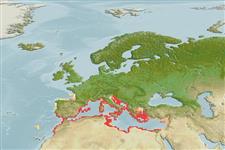Bivalvia |
Cardiida |
Cardiidae
Environment: milieu / climate zone / depth range / distribution range
Ecology
Benthic; depth range 2 - 60 m (Ref. 104492). Temperate; 46°N - 30°N, 18°W - 37°E
Eastern Atlantic and the Mediterranean. Subtropical.
Length at first maturity / Size / Weight / Age
Maturity: Lm ? range ? - ? cm
Maximum depth from Ref. 106813. Found on muddy sand with seaweed at a depth of 60 m (Ref. 106813). In general, suspension feeding bivalves mainly depend on phytoplankton and detritus material for nutrition (Ref. 107088).
Life cycle and mating behavior
Maturity | Reproduction | Spawning | Eggs | Fecundity | Larvae
Members of the class Bivalvia are mostly gonochoric, some are protandric hermaphrodites. Life cycle: Embryos develop into free-swimming trocophore larvae, succeeded by the bivalve veliger, resembling a miniature clam.
Gaspar, M.B., M.D. Dias, A. Campos, C.C. Monteiro, M.N. Santos, A. Chicharo and L. Chicharo. 2001. (Ref. 2714)
IUCN Red List Status (Ref. 130435)
CITES status (Ref. 108899)
Not Evaluated
Not Evaluated
Threat to humans
Harmless
Human uses
| FishSource |
Tools
More information
Age/Size
Growth
Length-weight
Length-length
Morphology
Larvae
Abundance
Internet sources
Estimates based on models
Preferred temperature
(Ref.
115969): 15.3 - 21.5, mean 18.7 (based on 144 cells).
